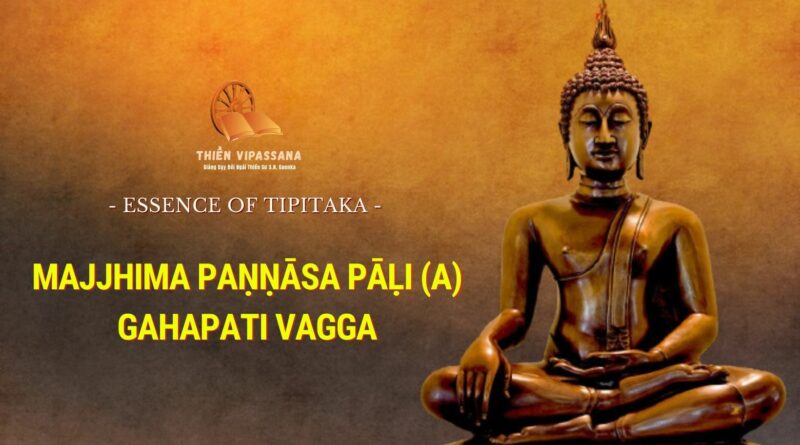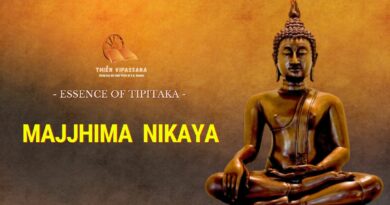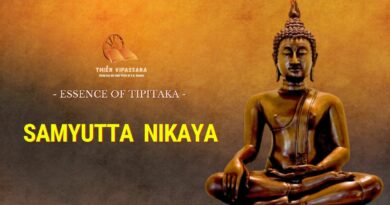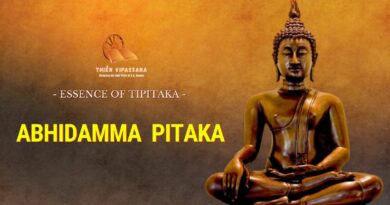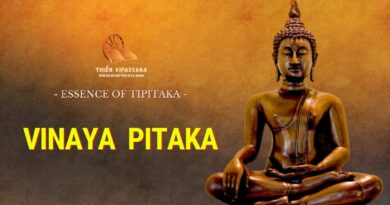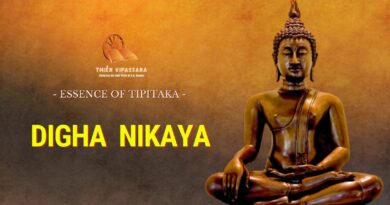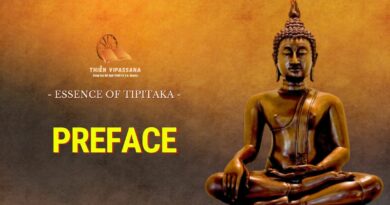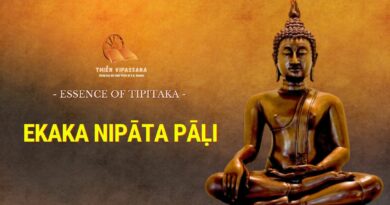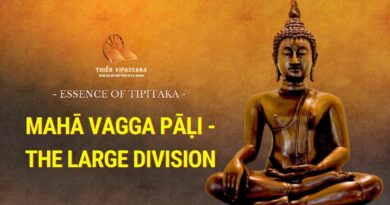2 Majjhima Paṇṇāsa Pāḷi
(a) Gahapati Vagga
Kandaraka Sutta
This discourse was delivered at Campā in connection with Kandaraka, the wandering ascetic, and Pessa, son of an elephant rider, who marvelled at the silence maintained by the huge congregation of bhikkhus not making any sound, not even a sneeze or a cough. The Buddha explained that their silence was due to their accomplishments in samādhi and to their training in four methods of steadfast mindfulness. The Buddha also elucidated the four types of individuals engaged in meditation.
Aṭṭhakanāgara Sutta
The householder Dasama of Aṭṭhaka wanted to know if there was a single dhamma which could cause liberation and realization of nibbāna. The Venerable Ānanda informed him there was a group of dhammas, eleven in number, namely the four jhānas, the four brahmavihārapractices, and ākāsānañcāyatana, viññāṇañcāya, ākiñcaññāyatana. Contemplating the impermanent nature of each of these dhammaswould lead one to nibbāna.
Sekha Sutta
This discourse was given by the Venerable Ānanda to the Sakyans headed by Prince Mahānāma. The Venerable Ānanda explained the path consisting of three steps-sīla, samādhi and paññā-to be followed by an aspirant to higher knowledge culminating in the knowledge of cessation of āsava.
Potaliya Sutta
Potaliya had left worldly affairs behind with a view to leading the holy life. When the Buddha saw him dressed in ordinary everyday attire, the Buddha addressed him as gahapati (householder), which Potaliya resented. The Buddha explained to him that in the vocabulary of the Vinaya one was said to have cut oneself off from the world only when one refrained from killing, stealing, telling lies, slandering, and only when one was abstemious, not conceited, and controlled in one’s temper.
Jīvaka Sutta
This discourse was given at Rājagaha in connection with Jīvaka, the great physician, who enquired whether it was true that the Buddha ate the meat of animals killed purposely for him. The Buddha told him that he had made it a rule for the bhikkhus not to partake of any meat which they saw or heard or had reason to suspect to be especially prepared for them. Further, a bhikkhu should not show eagerness for food nor be greedy in eating; he should eat with reflection that he took the meal only to sustain the body in order to pursue the path of liberation.
Upāli Sutta
A prominent, wealthy lay disciple of Nigaṇṭha Nāṭaputta was sent by his master to meet the Buddha and defeat him in argument on certain aspects of the theory of kamma. Whereas the Nigaṇṭha stressed the physical and vocal actions being more productive of resultant effects, the Buddha maintained that it was volition or mental action that was paramount. By means of his discourse the Buddha converted Upāli, while Nāṭaputta died, overwhelmed by intense wrath over the loss of his most prominent disciple.
Kukkuravatika Sutta
This discourse, given by the Buddha to two naked ascetics named Puṇṇa and Seniya at the market town of Koliya, deals with four kinds of actions and four kinds of resultant effects arising therefrom: (i) a black deed leading to a black result; (ii) a white deed leading to a white result; (iii) a deed which is both black and white leading to a result which is both black and white and (iv) a deed which is neither black nor white leading to a result which is neither black nor white.
Abhayarājakumāra Sutta
Prince Abhayarājakumāra was sent by Nigaṇṭha Nāṭaputta to ask the Buddha whether he uttered unpleasant words about the destiny of Devadatta. The Buddha enumerated six modes of utterances out of which he would make two modes of utterances: words which are true, profitable but not pleasant to others; and words which are true, profitable and pleasant to others.
Bahuvedanīya Sutta
This discourse was given at Sāvatthi to explain the various kinds of vedanā which might be two in number-sukha and dukkha vedanās; or three in number by including the upekkhā vedanā; or five, six, eighteen or thirty-six, or one hundred and eight, depending on the method of enumeration. Ordinarily sensations that arise from pleasures of the senses are regarded as sukha or happiness. But the Buddha explains that the acme of happiness is attainment of nirodha samāpatti.
Apaṇṇaka Sutta
This discourse was given by the Buddha to the villagers of Sālā in the country of Kosala who had not yet accepted any of the teachings taught by leaders of the various sects visiting their village. The Buddha showed them the right path which would not lead them astray. The wrong views of the sectarians were contrasted against the right views propounded by the Buddha; the disadvantages of wrong views, and the advantages of right views were explained. §
(b) Bhikkhu Vagga
Ambalaṭṭhikarāhulovāda Sutta
In this discourse, given at Rājagaha, the Buddha exhorted his son Rāhula, a sāmaṇera aged seven, on the necessity of observing the fundamental moral precept of truthfulness, and of practising mindfulness, by giving the similes of the upturned water pot, the royal elephant and the mirror.
Mahārāhulovāda Sutta
This discourse on the five khandhas was given at Sāvatthi by the Buddha to Rāhula at the age of eighteen. The Venerable Sāriputta also taught Rāhula the meditation on Anapana. The Buddha further explained to him the advantages of Anapana meditation and gave him another discourse on the four great elements.
Cūḷamālukya Sutta
This discourse was given at Sāvatthi to Bhikkhu Mālukya. Bhikkhu Mālukya interrupted his meditation one afternoon, went to the Buddha and asked him the well known classical questions: is the universe eternal or not etc.; is the soul the same as the body, is the soul one thing and body another, etc.; does life exist after death, or does it not exist after death.
The Buddha explained to him that the practice of the holy life did not depend upon these views. Whatever view one may hold about them, there would still be birth, ageing, decay, death, sorrow, lamentation, pain, grief, distress. The Buddha said that he taught only about dukkha, the cause of dukkha, the cessation of dukkha and the way leading to the cessation of dukkha.
Mahāmālukya Sutta
This discourse was given to Bhikkhu Mālukya at Sāvatthi to explain the five fetters, namely, personality belief, doubt, attachment to wrong practice, sensual desires and ill-will, which lead beings to lower destinations.
Bhaddāli Sutta
This discourse, given at Sāvatthi, is an exhortation to Bhikkhu Bhaddāli who refused to obey the disciplinary rule of not eating after midday and in the evening. The Buddha explained why bhikkhus in the teaching should respect disciplinary rules laid down by him.
Laṭukikopama Sutta
This discourse was given to the Venerable Udāyī in connection with observance of disciplinary rules and precepts. When the five strengths (balas), namely, faith, energy, mindfulness, concentration and insight are not well developed, the bhikkhu finds even a paltry restraint like refraining from eating meals in the afternoon and in the evening very irksome and onerous. But when the five balas are fully developed, even stringent rules can be observed without any difficulty or discomfort.
Cātumā Sutta
This discourse was given at Cātumā to the disciples of the Venerable Sāriputta and the Venerable Mahā Moggallāna, who came with five hundred bhikkhus to see the Buddha. The five hundred bhikkhus made a lot of noise while settling down. The Buddha refused to see them at first, but later relented and taught them the dangers in the life of a bhikkhu. Just as there are dangers and hazards in a sea such as stormy waves, crocodiles, whirlpools and sharks, so also there are dangers against which the bhikkhu must be always on guard, namely, ill-will against those who instruct them and guide them; dissatisfaction with training rules such as those concerning taking of meals or dealing with womenfolk; and pleasures of the senses.
Naḷakapāna Sutta
This discourse was given to the Venerable Anuruddha and to the villagers of Naḷakapāna to explain that unless a bhikkhu has attained the higher stages of magga and phala, accomplishments in supernormal psychic powers may prove to be harmful to him. The Buddha himself talked about the destinations of departed persons not to earn praise and admiration but to arouse enthusiasm and faith in his disciples.
Goliyāni Sutta
This discourse was given at Rājagaha by the Venerable Sāriputta to Goliyāni Bhikkhu concerning eighteen dhammas which a forest dwelling bhikkhu should observe.
Kīṭāgiri Sutta
This discourse was given at the market town of Kīṭāgiri on the advantages of taking meals only before noon and the disadvantages of eating in the evening. §
(c) Paribbājaka Vagga
Tevijjavaccha Sutta
Vacchagotta, the wandering ascetic, questioned the Buddha whether it would be true to say that sabbaññuta ñāṇa was constantly and continuously present to him all the time, while walking or standing, asleep or awake. The Buddha replied that it would not be true to say so. It would be true to say only that the Buddha was accomplished in the three kinds of knowledge, namely, knowledge of the past, power of divine seeing, and knowledge of liberation.
Aggivaccha Sutta
This discourse was given by the Buddha at Sāvatthi in connection with Vacchagotta who approached the Buddha quite often to ask many questions about atta. On this occasion too he asked the Buddha whether there was atta; whether atta was permanent, etc. The Buddha told him he held no theories about atta because he had seen the nature of things as they really were. Then he explained to him the Dhamma in some detail.
Mahāvaccha Sutta
This discourse was given by the Buddha to Vacchagotta at Rājagaha. On his visit to the Buddha after a long interval, Vacchagotta no longer troubled the Buddha with his speculations about atta, loka, etc. Instead, he requested to be taught on good and bad deeds (kusalākusalaṃ kammaṃ) in brief. The Buddha explained to him the Dhamma on good and bad deeds in brief as well as in detail.
Vacchagotta became a disciple of the Buddha and received admission into the order. Then, practising the Dhamma as instructed, he ultimately attained arahatship, realizing nibbāna. The problems of atta, loka, etc., no longer obsessed him.
Dīghanakha Sutta
This important discourse was given by the Buddha in the Sūkarakhata Cave near Rājagaha to Dīghanakha, the wandering ascetic and a nephew of the Venerable Sāriputta, in order to remove his wrong views of annihilation. As the Buddha taught him the dhamma on contemplation of the body and contemplation of sensation (sukha, dukkha, adukkhamasukha), his uncle the Venerable Sāriputta was standing behind the Buddha, fanning him. It was only fifteen days ago that the Venerable Sāriputta had been admitted into the order by the Buddha. While following the progress of the discourse, as though sharing the food prepared for another, the Venerable Sāriputta advanced rapidly from the stage of a sotāpanna, which he had already reached, and attained the perfect state of arahatship with the fourfold analytical knowledge (paṭisambhidā ñāṇa). At the end of the discourse his nephew, the wandering ascetic Dīghanakha, became a sotāpanna.
Māgandiya Sutta
This discourse was given by the Buddha at the market town of Kammāsadhamma in the Kuru country in connection with Māgandiya, the wandering ascetic, who resented the Buddha’s criticism of his wrong beliefs. The Buddha exhorted him to practise control of the senses and sensuous thoughts. He told the wandering ascetic the story of his renunciation, how he had left his luxurious palaces and how, on discovering the truth, he found happiness in arahattaphala which was far superior to any of the sensuous pleasures. Māgandiya gave up his wrong views to become a disciple of the Buddha.
Sandaka Sutta
This discourse was given at Kosambī to Sandaka, the wandering ascetic, and his followers by the Venerable Ānanda. The Venerable Ānanda explained to them the four wrong views of sect-leaders who held that there was no existence after death, that there was neither evil nor good, no cause for any phenomena, and that there were only aggregates of seven elements. Finally he taught the wandering ascetics the Dhamma as expounded by the Buddha. As a consequence of his teaching Sandaka and his followers abandoned their wrong views and became disciples of the Buddha.
Mahāsakuludāyī Sutta
At one time the Buddha and his company of bhikkhus were residing at Rājagaha where six leaders of sects were also spending the rains with their respective followers. Then Udāyī, the wandering ascetic, who was visited by the Buddha, extolled the virtues of the Buddha saying that other leaders were sometimes criticized even by their followers, whereas the Buddha was the exception. Even if the Buddha’s disciples left the order, they did not find fault with the Buddha or the Dhamma. They only blamed themselves for not being able to follow his teaching. Udāyī attributed this difference in reverential respect enjoyed by the Buddha to five aspects of his virtues. The Buddha rejected Udāyī’s enumeration of his virtues which were mostly attributed to ascetic practices, and explained to him the real cause of the total veneration bestowed on him by his followers.
Samaṇamuṇḍika Sutta
The wandering ascetic Uggāhamāna, son of Samaṇamuṇḍika, was teaching that any recluse who refrained from wrong deed, wrong word, wrong thought, and wrong livelihood was a fully accomplished arahat. The Buddha rejected his assertion, saying that in that case, even an infant sleeping innocently upon his bed could claim to the state of arahatship. He then explained that it was only the Noble Path of Eight Constituents leading to Right Knowledge and Right Liberation that could bring about realization of arahatship.
Cūḷasakuludāyī Sutta
This discourse was given at Rājagaha. The wandering ascetic Sakuludāyī asked the Buddha many questions about atta and sīla, and the Buddha explained to him the practice of the teaching beginning with the precept of not taking the life of a being and ending with the realization of nibbāna.
Vekhanasa Sutta
This discourse was given at Sāvatthi. The Buddha explained to Vekhanasa, the wandering ascetic, how happiness accruing from spiritual attainments was superior to that derived from sensuous pleasures. The Buddha also gave the assurance that any honest worker who would follow his instructions sincerely could enjoy the bliss of spiritual attainments. §
(d) Rāja Vagga
Ghaṭīkāra Sutta
This discourse, given by the Buddha while journeying in Kosala, recounts the story of high devotion of Ghaṭīkāra, the potter, who looked after his blind parents and who at the same time attended upon Kassapa Buddha with great reverence. There was also the account of how Ghaṭīkāra forcibly pulled along his friend, young Jotipāla, to where Kassapa Buddha was, to pay respect. After hearing the Dhamma discourses young Jotipāla left the household life to be admitted into the order by Kassapa Buddha. This interesting ancient episode that had happened in Kassapa Buddha’s time many aeons ago was recounted to the Venerable Ānanda by Gotama Buddha standing on the very spot where once stood, a long, long time ago, the house of Ghaṭīkāra, the potter. The Buddha concluded his story by revealing that young Jotipāla was none other than the present Gotama Buddha.
Raṭṭhapāla Sutta
Raṭṭhapāla, the son of a wealthy brahmin obtained his parents’ permission with great difficulty to become a bhikkhu under the guidance of the Buddha. After twelve years of strenuous endeavour, when he became a fully-fledged arahat, he visited his parents’ home. His parents attempted to entice him with wealth and wife back to household life but to no avail. He taught his parents the law of impermanence (anicca). He said he saw nothing alluring in wealth and marriage.
Maghādeva Sutta
This discourse was given at the royal mango grove at Mithilā. The Buddha told the Venerable Ānanda about the noble tradition laid down by the righteous King Maghādeva. When his hair began to turn white, he gave up the household life leaving his dominions to his eldest son. This tradition was handed down from king to son for generations and generations, over thousands and thousands of years until the reign of King Nimi.
King Nimi had a son by the name of Kaḷārajanaka who did not go forth from home life into homelessness when the time came like his predecessors. Kaḷārajanaka terminated the noble practice laid down by the tradition. He thus became the last person of that tradition.
The Buddha revealed that he was the King Maghādeva of that ancient time laying down the noble tradition. The Buddha said that noble tradition did not lead to calm, to higher knowledge. It only led to the realm of the Brahmās. But the noble practice which he was leading now as a Buddha certainly led to the disillusionment with the five khandhas, the abandonment of attachment and the cessation of dukkha, and to calm, higher knowledge, penetrative insight and realization of nibbāna. The Buddha then exhorted, “Ānanda, continue to follow this good practice which I have laid down. Let you not be the person with whom my tradition ends.”
Madhura Sutta
This discourse was given by the Venerable Mahākaccāna at Madhurā. He refuted the brahmins’ claim that only brahmins were noble and superior, and that others were inferior. He explained to King Mādhura that it was one’s morality, not birth, that established one’s nobility. Anyone whether brāhmaṇa, khattiya, vessa or sudda, committing a wrong deed would be born again in the states of woe; anyone doing a good deed would be born again in a happy realm. After this discourse by the Venerable Mahākaccāna, King Madhurā, formerly of another faith, took refuge in the Buddha, the Dhamma and the Sangha.
Bodhirājakumāra Sutta
This discourse was given by the Buddha at Susumāragira in the country of Bhaggā in connection with the statement made by Prince Bodhi that “sukha (happiness) cannot be attained through sukha; sukha can be attained only through dukkha“. The Buddha said he had also once thought in a similar manner, and recounted the whole story of his renunciation, his struggles with wrong practices, his frantic search for the truth, and his ultimate enlightenment. When asked by the prince how long would it take a bhikkhu to achieve, in this very lifetime the supreme goal of the holy life, arahatship, the Buddha stipulated five attributes for the aspiring bhikkhu. If he was equipped with five attributes: faith, good health, integrity (not being deceitful), unrelenting zeal, and sufficient intellect to understand the phenomena of “arising and passing away”, and having the tathāgata as his instructor and guide, a bhikkhu would achieve arahatship within seven years at most. Under the most favorable circumstances he could become accomplished within half a day.
Aṅgulimāla Sutta
This discourse, given by the Buddha at Sāvatthi, describes how Aṅgulimāla, the notorious robber and murderer, was tamed by the Buddha, and how he took refuge in the Buddha, the Dhamma and the Sangha. Although he had the name of Ahiṃsaka (non-violence), he was formerly cruel and murderous and was called Aṅgulimāla by people. Being tamed now by the Buddha, he ceased hurting anyone, and started living a life true to his name. He had become an arahat.
Piyajātika Sutta
A householder of Sāvatthi whose son had died went to see the Buddha who told him that dear beloved ones formed a source of sorrow as they brought pain and grief. The householder was displeased with what the Buddha said. Gamblers playing with dice just close by the Buddha’s monastery told him differently. They said that loved ones surely brought joy and happiness. King Pasenadi concurred with the gamblers but his queen Mallikā maintained that only what the Buddha said must be true. She justified her faith in the Buddha by giving many illustrations of the Buddha’s penetrating and illuminating wisdom. King Pasenadi was finally won over to her view.
Bāhitika Sutta
This discourse was given at Sāvatthi by the Venerable Ānanda to King Pasenadi on the bank of the River Aciravatī. He dealt with unwholesome deeds, words and thoughts which were blameworthy and wholesome deeds, words and thoughts which were praiseworthy. King Pasenadi was pleased with the discourse and made a gift of cloth from the country of Bāhiti to the Venerable Ānanda.
Dhammacetiya Sutta
King Pasenadi of Kosala once came to see the Buddha. Entering the dwelling where the Buddha was staying, he fell on his forehead at the feet of the Buddha. When asked by the Buddha why he was showing such extreme humbleness and respect to the body of the Buddha, the king launched eloquently on a eulogy of the Buddha, praising his virtues. The Buddha told his bhikkhus that the words uttered by the king constituted a memorial in honour of the Dhamma and urged them to learn this memorial and recite it frequently.
Kaṇṇakatthala Sutta
This discourse, given by the Buddha at Ujuñña, contains answers to King Pasenadi Kosala’s questions about four classes of people and their destinations after death, about sabbaññuta ñāṇa, and about the great Brahmā. §
(e) Brāhmaṇa Vagga
Brahmāyu Sutta
The Brahmin Brahmāyu was one hundred and twenty years old when he heard of the fame of the Buddha. He sent his disciple Uttara who was well versed in Vedas to find out by examining the thirty-two physical characteristics of a great man whether Gotama was indeed an enlightened Buddha. On Uttara’s good report testifying to the Buddha having the requisite characteristics of a Buddha, Brahmāyu went himself to see the Buddha. Fully satisfied after hearing the graduated discourse that Gotama was indeed an enlightened Buddha, he became a devoted disciple and achieved the third stage of the path and fruition (anāgāmi), before he passed away.
Sela Sutta
Sela was a brahmin of Āpana market-town who, on hearing about the fame of the Buddha from Keṇiya the hermit, went to see the Buddha accompanied by three hundred young brahmins. After hearing a discourse from the Buddha he became fully convinced that he had indeed seen a truly enlightened Buddha. All of them requested to join the order and received permission from the Buddha.
Assalāyana Sutta
Some five hundred brahmins who had come to Sāvatthi on business attempted to challenge the Buddha on his views with regard to the purity and nobility of the four classes of people. They sent Assalāyana, a highly talented young man well-versed in the Vedas, to contest with the Buddha. The young man’s meeting with the Buddha ended up in his conversion.
Ghoṭamukha Sutta
A discussion took place between the Venerable Udena and a brahmin by the name of Ghoṭamukha on the subject of the practice of the holy life. The Venerable Udena described four kinds of persons engaged in ascetic practices. After the discourse the brahmin became a disciple of the Venerable Udena and took his refuge in the Buddha, the Dhamma and the Sangha.
Caṅkī Sutta
Caṅkī, a brahmin of Opasāda Village, came to see the Buddha with a large crowd amongst whom was a young brahmin by the name of Kāpaṭika. The young man entered into a discussion with the Buddha about the “Three Vedas” which had been handed down from generation to generation in unbroken tradition. The tradition which the brahmins believed to be the only truth was likened by the Buddha to a line of blind men each one clinging on to the preceding one.
Esukārī Sutta
This discourse was given at Sāvatthi in connection with a brahmin named Esukārī. In this sutta too the Buddha rejected the brahmin classification of society into four classes claiming the highest position for the brahmins. It was not only the brahmins who could develop loving-kindness, free from enmity and ill-will. Members of other classes also could develop loving-kindness. It was not birth but the practice of wholesome dhamma that made a person noble.
Dhanañjāni Sutta
Dhanañjāni was an old devoted lay disciple of the Buddha. After the death of his first wife who had great faith in the Buddha, the Dhamma and the Sangha, he was no longer diligent in and mindful of the practice of Dhamma. His second wife was without faith in the teaching of the Buddha. To maintain his family he resorted to wrongful means of livelihood. The Venerable Sāriputta put him back on the right path. On his deathbed, he sent for the Venerable Sāriputta who solaced him with the Dhamma. This caused him on his death to be reborn in the Brahmā world. The Buddha asked the Venerable Sāriputta why he had put the old brahmin only on the way to the inferior Brahmā world when a higher attainment was possible for him.
Vāseṭṭha Sutta
A discussion had arisen between two brahmin youths Vāseṭṭha and Bhāradvāja on the origin of a brāhmaṇa. Bhāradvāja maintained it was birth, lineage and caste that made a person a brāhmaṇa. Vāseṭṭha believed moral conduct and performance of customary duties were essential qualifications to be a brāhmaṇa. They went to the Buddha for settlement of their dispute.
The Buddha told them that a person was not a brāhmaṇa just because of his birth if he was full of worldly attachments, or was harnessed to greed, ill-will, craving and ignorance. A person became a brāhmaṇa, whatever his birth, when he had cut off his fetters of defilements, removed the obstacles of ignorance and attained the knowledge of the Four Noble Truths. The most perfect brāhmaṇa was an arahat.
Subha Sutta
This discourse was given on account of Subha, son of the brahmin Todeyya, at Sāvatthi. Like other brahmins, Subha believed that only householders could accomplish meritorious deeds in a right manner, not those who had gone forth from the household life. The occupation of householders produced great benefits whereas the occupation of the recluse brought little benefits. The Buddha removed his wrong views and Subha became a devoted disciple of the Buddha.
Saṅgārava Sutta
Saṅgārava was a young brahmin who was full of pride with learning in the Vedas, entertaining wrong views of his birth. He went to ask the Buddha whether the Buddha claimed, like some samaṇas and brāhmaṇas, to have attained in this very life special knowledge and vision and to have reached the other shore. The Buddha explained that there were three kinds of samaṇas and brāhmaṇas who made such claims: those who made the claim through hearsay, having learnt things by hearsay only; those who made the claim by mere reasoning and logic; and finally those who made the claim by personally realizing the penetrative insight of the Dhamma unheard of before.
The Buddha told Saṅgārava that he was of this third type and recounted how he had become accomplished in the Dhamma by practice and self-realization.

